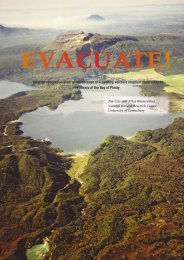Volcanoes - Ministry of Civil Defence and Emergency Management
Volcanoes - Ministry of Civil Defence and Emergency Management
Volcanoes - Ministry of Civil Defence and Emergency Management
You also want an ePaper? Increase the reach of your titles
YUMPU automatically turns print PDFs into web optimized ePapers that Google loves.
to return. How are we going to cope with the large<br />
number <strong>of</strong> evacuees?<br />
Under the new Group arrangements, the<br />
benefits are that we all pool all our resources, share our<br />
concerns, investigate the likelihood <strong>of</strong> certain events or<br />
hazards occurring <strong>and</strong> then plan to fulfil the Reduction,<br />
Readiness, Response <strong>and</strong> Recovery action.<br />
THE EVACUATION PROCESS<br />
Imagine the evacuation process for a moment.<br />
Shifting many displaced people from one location to<br />
a safer location. How are you going to get there? Are<br />
the roads open? Have the rail links been affected? Are<br />
there enough rolling stock <strong>and</strong> other forms <strong>of</strong> bulk<br />
transport available to shift the livestock? What roads are<br />
open? How many bridges are still operational? Where<br />
are the detours? How prepared are those communities<br />
outside the disaster area to take such vast numbers. The<br />
sheer logistics <strong>of</strong> the operation starts to sink in. What<br />
lifelines are still functioning? Will road transport be<br />
able to function with the presence <strong>of</strong> large amounts <strong>of</strong><br />
ash affecting engines, electrics <strong>and</strong> brakes? Relive the<br />
evacuation <strong>of</strong> Dunkirk. Perhaps evacuation by sea may<br />
have to be part <strong>of</strong> the evacuation plan? We know for<br />
sure that our isolation in a far-flung corner <strong>of</strong> the Pacific<br />
means there will be limitations on international help.<br />
There certainly will not be convoys <strong>of</strong> trucks coming<br />
across the Tasman as would overl<strong>and</strong> aid in a European<br />
disaster. Will there be enough craft to do this. What<br />
part will the weather play. So it goes on.<br />
We are fortunate that in our region there are<br />
people who experienced the Rabaul eruption <strong>of</strong> 1991.<br />
Their first h<strong>and</strong> on the ground experiences have been<br />
well documented giving a realistic translation <strong>of</strong> events<br />
<strong>and</strong> what impacts they would have if such a catastrophic<br />
event occurred in our more densely population region.<br />
In 1996, GNS published a Science Report<br />
entitled “Guidelines for developing a response to a<br />
volcanic crisis in the Bay <strong>of</strong> Plenty”, co-authored by D M<br />
Johnston, B J Scott <strong>and</strong> B F Houghton. The aim <strong>of</strong> the<br />
report was to identify significant issues that need to be<br />
considered in developing a response to a volcanic crisis<br />
affecting the Bay <strong>of</strong> Plenty region. It should be noted<br />
that volcanologists as stated in this report refer to a<br />
“volcanic crisis” as the whole realm <strong>of</strong> events concerned<br />
with the awakening <strong>of</strong> a volcano, the building up to an<br />
eruption, the eruption <strong>and</strong> the aftermath as the affected<br />
region/area recovers.” This <strong>of</strong> course covers the steps<br />
any plan must have for a comprehensive emergency<br />
management approach, part <strong>of</strong> an ‘all hazards’ strategy,<br />
linking mitigation, preparedness, response <strong>and</strong> recovery.<br />
Plans above all must be simple <strong>and</strong> flexible, focusing on<br />
principles rather than details. An excellent observation<br />
made in the report was that ‘the contingency planning<br />
Okataina Volcanic Centre<br />
process is a continuous one (ie. the plan is never<br />
complete). The report describes evacuation <strong>and</strong><br />
evacuation planning as follows:<br />
Evacuations usually involve four types <strong>of</strong><br />
movement:<br />
1. Self-evacuation where people move out in their own<br />
vehicles or with friends/relatives.<br />
2. Movement <strong>of</strong> people who do not own or have access<br />
to private vehicles.<br />
3. Movement <strong>of</strong> people from institutions (hospitals, but<br />
no prisons in Bay <strong>of</strong> Plenty).<br />
4. Movement <strong>of</strong> people with h<strong>and</strong>icaps who require<br />
specialized vehicles.<br />
<strong>Emergency</strong> planning must make provisions for<br />
all <strong>of</strong> these.<br />
55<br />
TEPHRA<br />
June 2004

















